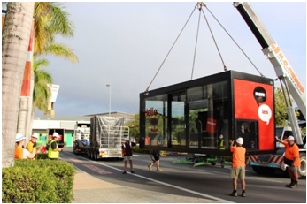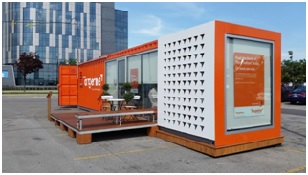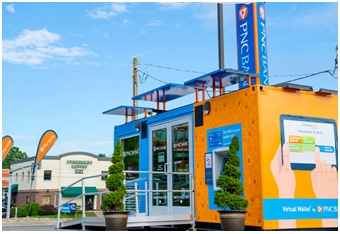5 minutes
Pop-ups provide a quicker way to restore service delivery while branches are being rebuilt.
In the Northwest, the likely natural disasters are earthquakes and floods. In the Southeast, hurricanes and tornados. No matter where you are, your credit union can experience a fire, gas explosion or flooding. Branches are not immune to the aftermath of any of these disasters. When service delivery comes to a stop at your usual locations, members may experience significant inconvenience and additional stress during what is already a difficult time.
Today virtual delivery can provide at least some services via technology while a branch location is being rebuilt. But it takes eight to 14 months to rebuild most branches and four to six months to renovate, which constitutes plenty of time for members to look at moving to another institution that has physical branches in operation.
 A few years ago, one of our bank clients suffered a fire that required demolition of one of its largest branches. We were able to work with a supplier of modular buildings, much like a school portable, to provide a temporary location during the 10 months it took to get the new branch designed, permitted and constructed. Unfortunately, it took three months to permit, relocate and retrofit the modular buildings. Today there is a faster way to do something similar: pop-up branches.
A few years ago, one of our bank clients suffered a fire that required demolition of one of its largest branches. We were able to work with a supplier of modular buildings, much like a school portable, to provide a temporary location during the 10 months it took to get the new branch designed, permitted and constructed. Unfortunately, it took three months to permit, relocate and retrofit the modular buildings. Today there is a faster way to do something similar: pop-up branches.
Pop-up branches started to appear about 10 years ago as a temporary location novelty. These mini-branches are becoming more prevalent for four reasons:
1. to test a new/emerging market at a low cost with flexibility to relocate to another site.
2. can be located in a branch parking lot after a disaster.
3. can be used as a temporary facility during a major remodel.
4. can be placed at major events like state fairs.
For pop-up branches to be valuable in a disaster situation, they must be readily available. It can take two to three months to have one constructed, which is not much help when you need one in a week. If you are a large institution, you may be able afford to have one or two modular units available. They might even be actively in use as a component of your branching array. Availability is more difficult for mid-size or small credit unions.
A pop up with equipment can cost $300,000 to $850,000. The final figure depends on the equipment, size and how many of the same design are produced. Transportation and site adaptation costs would be in addition to these estimates.
What if credit unions worked together with their regulators, leagues or credit union service organizations to fund development of pop-up branches for use in emergencies? They could be loaned or leased out to one credit union in a disaster or, in situation like Houston, placed to provide financial services as a representation of how local credit union unions come together to serve their communities in times of need. Another idea would be to collectively create a network of pop-up branches that could be transported to disaster areas when needed. The Federal Emergency Management Agency might provide funds during recovery if an agreement could be negotiated in advance.
 Pop-up branches come in many sizes from small 80-squar-foot pods to single mini-branches similar in size to a 160-square-foot shipping container or to double units upwards of 320 square feet. All of these can easily be trucked to a site and unloaded and positioned on the ground or an elevated platform. Americans With Disabilities Act requirements can be accommodated with a modular and adjustable ramp.
Pop-up branches come in many sizes from small 80-squar-foot pods to single mini-branches similar in size to a 160-square-foot shipping container or to double units upwards of 320 square feet. All of these can easily be trucked to a site and unloaded and positioned on the ground or an elevated platform. Americans With Disabilities Act requirements can be accommodated with a modular and adjustable ramp.
Because these are small spaces from which to operate, the interior must be very efficient. Fortunately, technology helps by providing electronic services that can be powered by temporary electrical or a generator. Data, phone and security can all be provided via cell towers or even satellite phones, in a worst case. The biggest human drawback is the lack of toilets, which are provided in only the biggest units.
ATM pods are also an option at significantly less expense than pop ups—$150,000 to $275,000, also depending on equipment, size, transportation, site adaptation costs and how many of the same design are produced.
These mobile units can provide full-service using video conferencing while taking deposits and providing cash. While there is some risk that the credit union can literally be hijacked, the risk can be mitigated with constant monitoring and a tracking device.
 The size and complexity of ATM pods varies. The smallest at six feet by eight feet can support an exterior ATM. A mid-size unit of eight feet by 12 feet can provide an interior ATM out of the weather. A still larger unit of 10 feet by 15 feet can include both an ATM and a place for a staff member.
The size and complexity of ATM pods varies. The smallest at six feet by eight feet can support an exterior ATM. A mid-size unit of eight feet by 12 feet can provide an interior ATM out of the weather. A still larger unit of 10 feet by 15 feet can include both an ATM and a place for a staff member.
We must consider the member experience outside the pod. Awnings can protect members waiting outside. The ground around the pod may not be dry. Metal grates can be placed on the ground to provide solid footing. Member security is a major issue during disasters, as criminals take advantage of a bad situation. Power may be out when the pod is located and there may be no street lighting. The pod should be surrounded with good lighting of at least 20 lumens. Additionally, obvious cameras should be placed around the pod.
Recently, The Financial Brand wrote a very informative article about how pop-up branches are being used by a few financial institutions. I suggest reading this article to learn more about the concept and how it might supplement your current branching network and potentially help mitigate the risk of unforeseen branch closures.
Other research can be done at Let’s Talk Payments, Bankrate and Winnipeg Sun.
Paul Seibert, CMC, is an independent facilities and real estate consultant under Paul Seibert Consulting, Seattle.





